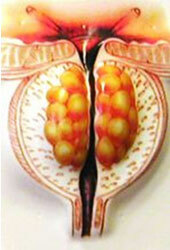It is generally accepted that 85% of men are somehow exposed to this disease.
Benign prostatic hyperplasia( adenoma) is a tumor consisting of small nodules gradually growing and squeezing the urethra. If the urinary canal had not crossed the prostate gland, then nobody would have ever heard of this disease.
Previously, benign prostatic hyperplasia was called:
- prostatic disease;
- hemorrhoids of the bladder;
- of the prostate adenoma;
- adenoma of the periurethral glands;
- by dysgormonal adenomatous prostatopathy;
- by nodal hyperplasia of the prostate.
Today, all urologists recognize that the name "benign prostatic hyperplasia" more accurately and fully reflects the pathological nature of the disease.
Adenomatous hyperplasia of the prostate is prone to benign growth, which means complete absence of metastases( spread to surrounding organs).This is a fundamental difference from prostate cancer.
Causes of hyperplasia of the prostate
Until now, the causes of the disease remain unclear.
It is commonly believed that prostate adenoma is one of the main manifestations of the onset of men's menopause. Hence, one can conclude that all elderly men are at risk of getting prostate adenoma.
No relationship has been established between adenoma of the prostate and:
- of sexually transmitted diseases;
- with inflammatory diseases of the genital organs;
- using alcohol and tobacco;
- sexual orientation;
- sexual activity.
Symptoms of prostatic hyperplasia
 The main symptom of the disease is, of course, a malfunction of urination.
The main symptom of the disease is, of course, a malfunction of urination.
It is generally believed that the onset of the disease should be sought at a time when urination is no longer pleasurable. It is this period that is considered the most suitable for the first visit to a doctor. After a certain period of time, urination becomes less intense and free, but more rapid. The amount of urine in one portion decreases, the urine stream is noticeably weaker. At night there is a need to get up two or more times for the next trip to the toilet. There are very strong urge to urinate. Over time, urination is more and more difficult, the stream is weakened to such a degree that it begins to fall precipitously.
When urinating, you have to strain so hard that, at short intervals, you have to make forced stops for rest.
Then in such patients begins to manifest:
- irritability;
- weakness;
- dry mouth;
- constant thirst;
- headache;
- kidney failure.
The urinary bladder is constantly filled with urine, and the process of urination passes in the form of a thin trickle or even droplets. Urinary incontinence occurs when it is excreted by droplets around the clock( even at night).
Nodular hyperplasia of the prostate
It can be said that the nodal hyperplasia is a kind of characteristic change in benign hyperplasia and consists not only in the growth of the number of tumor cells, but also in the change in the structure of the acini and ducts.
Treatment of benign prostatic hyperplasia
Treatment can be of three types:
- medicated;
- operative;
- is not operational.
Drug treatment is performed only when urine is completely and completely removed from the bladder.
Today, there are a number of drugs for the treatment of benign prostatic hyperplasia. They can reduce the volume of the gland and soften the course of the disease. However, the use of these drugs is possible only under the full control of the attending physician.
Non-operative methods include:
- balloon dilatation;
- thermal therapy;
- hyperthermia;
- catheterization of the bladder.
Operative methods of treatment are the most effective for today.
Modern medical treatment consists of the use of special medications intended to directly affect the work of the prostate .The main goal of treatment is to remove the main symptoms of the disease, improve the quality of life.
In total, there are two types of drugs designed to treat this disease:
- drugs that relieve tension from the smooth muscles of the prostate;
- drugs that reduce the volume of the prostate.
The result of the use of these drugs is an improvement in the outflow of urine and a reduction in the symptoms of the disease.
Contraindications for medication:
- individual drug intolerance;
- severe degrees of hepatic and renal insufficiency;
- stones in the bladder;
- scarring process in pelvic organs;
- is a neurogenic disorder;
- exacerbation of inflammation in the lower urinary tract;
- suspected of prostate cancer.
Video: Hyperplasia of the prostate
 Prostate adenoma is the most common urological problem of the male body.
Prostate adenoma is the most common urological problem of the male body.

